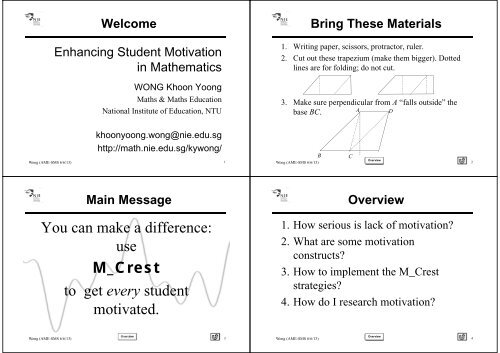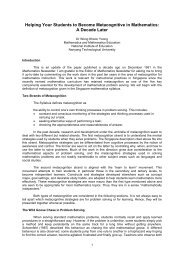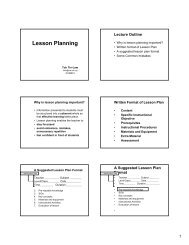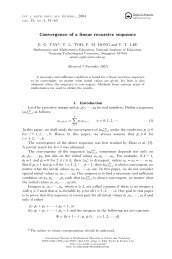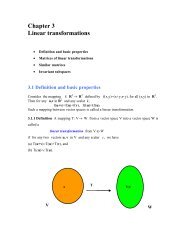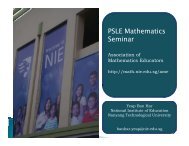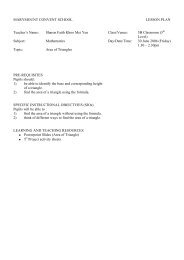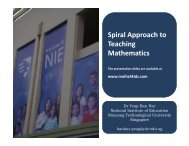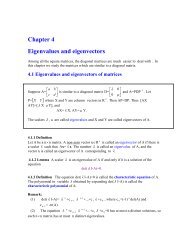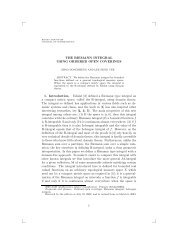Enhancing student motivation in mathematics through teacher ...
Enhancing student motivation in mathematics through teacher ...
Enhancing student motivation in mathematics through teacher ...
You also want an ePaper? Increase the reach of your titles
YUMPU automatically turns print PDFs into web optimized ePapers that Google loves.
Demotivated “Adjectives”1. Th<strong>in</strong>k of <strong>student</strong>s who are notmotivated to learn Math.2. Jot down at least five adjectives.Negative ExperiencesSelf-esteem (emotion)Behaviour (repeated failure)Straits Times, M<strong>in</strong>d Your Body,April 9, 2009, p. 7.Sunday Times,28 Sept 2003, p. 54.Wong (AME-SMS 6/6/13)Overview13Wong (AME-SMS 6/6/13)Overview14High Math AnxietyNegative Trumps Positive• Smaller work<strong>in</strong>g memory span;cannot pay attention.• Less resources for learn<strong>in</strong>g andperformance; poor problem solv<strong>in</strong>g.• Resort to rules rather than th<strong>in</strong>k<strong>in</strong>g.Wong (AME-SMS 6/6/13)Overview15• Hattie (p. 48): de<strong>motivation</strong> moreimpactful than <strong>motivation</strong>.• Not all <strong>student</strong>s respond positively tomotivat<strong>in</strong>g strategies (positive emotions).• One negative <strong>in</strong>cident (anxiety, fear,frustration, ignored) could “destroy”effects of motivat<strong>in</strong>g practices; lastlonger.• Do no harm.OverviewWong (AME-SMS 6/6/13) 16
MOE: Attitude• Mak<strong>in</strong>g the learn<strong>in</strong>g of <strong>mathematics</strong> fun,mean<strong>in</strong>gful and relevant goes a long way to<strong>in</strong>culcat<strong>in</strong>g positive attitudes towards thesubject.• Care and attention should be given to thedesign of learn<strong>in</strong>g activities, to buildconfidence <strong>in</strong> and develop appreciation for thesubject. (p. 9)• Emphasis on <strong>in</strong>tr<strong>in</strong>sic <strong>motivation</strong>; provide richlearn<strong>in</strong>g experiences.OverviewWong (AME-SMS 6/6/13) 17OverviewWong (AME-SMS 6/6/13) 18M_Crest: Your Ideas• M_• C_• R_• E_• S_• T_Wong (AME-SMS 6/6/13)Overview19OverviewWong (AME-SMS 6/6/13) 20
Mean<strong>in</strong>gful; Sense Mak<strong>in</strong>g• Explanations us<strong>in</strong>g words andsymbols not engag<strong>in</strong>g.• Many rules, esp. algebra, not mademean<strong>in</strong>gful to <strong>student</strong>s, lead<strong>in</strong>g too resort to memorisation, easilyforgotten;o many misconceptions and errors;o demotivated.OverviewWong (AME-SMS 6/6/13) 21Famous People• Bertrand Russell (1872 – 1970): I was made tolearn by heart: ‘The square of the sum of twonumbers is equal to the sum of their squares<strong>in</strong>creased by twice their product’.I had not the vaguest idea of what this meant,and when I could not remember the words, mytutor threw the book at my head, which didnot stimulate my <strong>in</strong>tellect <strong>in</strong> any way. (1907)• Carl Jung (1875 – 1961): I was so <strong>in</strong>timidatedby my <strong>in</strong>comprehension (of algebra) that I didnot dare to ask any questions.OverviewWong (AME-SMS 6/6/13) 22Concrete, Patterns, Visual1. Concrete materials + explanations;multi-model representations.2. Patterns, powerful l<strong>in</strong>k to priorlearn<strong>in</strong>g; <strong>teacher</strong>s should knowwhen patterns “break down”.3. Visual representation and proofs.Area of Parallelogram• Standard justification; concrete.• Dienes’ Variability pr<strong>in</strong>ciples.• Rule still applies if perpendicular is “outsidebase”?• How many proofs? Creative, differentiated.OverviewWong (AME-SMS 6/6/13) 23OverviewWong (AME-SMS 6/6/13) 24
Multi-modalTh<strong>in</strong>kboard:A holistic view!Multi-Modal: ParallelogramMaths = Study Patterns• G.H. Hardy (A Mathematician’s Apology, p. 84).• A mathematician, like a pa<strong>in</strong>ter or a poet, is amaker of patterns.• If his patterns are more permanent than theirs, itis because they are made with ideas.• Patterns Abstract ideas StructuresWong (AME-SMS 6/6/13)Overview25OverviewWong (AME-SMS 6/6/13) 26Patterns: IntegersMake Sense via Diagrams• Addition, subtraction, compare.• What can you deduce from these pictures?xyOperationAdditionSecond numberPositive NegativexySubtractionc• Other topics: a 0 = 1; circle properties, etc.OverviewWong (AME-SMS 6/6/13) 27da aNielsen (1993)Wong (AME-SMS 6/6/13) 28bd
Teacher Clarity• Most desirable characteristics.• Hattie (2009, p. 126): High effect size, d= 0.75, rank 8 among 138 <strong>in</strong>fluences.• Students know what to do, mean<strong>in</strong>gs ofwhat they are do<strong>in</strong>g.OverviewWong (AME-SMS 6/6/13) 29OverviewWong (AME-SMS 6/6/13) 30Confidence• If mean<strong>in</strong>gful, higher confidence.• Build confidence: Beg<strong>in</strong> with problemsthat every <strong>student</strong> can do. Gradedproblems.• Students must feel that they are mak<strong>in</strong>gprogress, with suitable feedback, notnecessarily solve it <strong>in</strong>stantly.• Ex: Sudoku: http://view.websudoku.com• Celebrate small successes; then biggersuccess. Set realistic targets.Csikszentmihalyi: Flow• Flow,http://en.wikipedia.org/wiki/Mihaly_Csikszentmihalyi• Match between skill and challenge.OverviewWong (AME-SMS 6/6/13) 31OverviewWong (AME-SMS 6/6/13) 32
Praise• Use praise to <strong>in</strong>still confidence?• Dweck: M<strong>in</strong>dset; p. 175.• You learned that so quickly! You’re sosmart!• Hidden message: If I don’t learntsometh<strong>in</strong>g quickly, I’m not smart.• Test your <strong>student</strong>’s m<strong>in</strong>dset:http://m<strong>in</strong>dsetonl<strong>in</strong>e.com/testyourm<strong>in</strong>dset/step1.phpOverviewWong (AME-SMS 6/6/13) 33Praise: Ability vs. Effort• Dweck: M<strong>in</strong>dset.Types Examples OutcomesAbility;fixed m<strong>in</strong>dsetEffort;growthm<strong>in</strong>dsetNo praiseBoth?So smart, likeE<strong>in</strong>ste<strong>in</strong>!You have put <strong>in</strong> a lotof hard work.Avoid challeng<strong>in</strong>g tasks;fear of failure; poorresults, lie about scores.Will<strong>in</strong>g to try hardproblems, improvescores, more engaged.Similar to fixed m<strong>in</strong>dset.OverviewWong (AME-SMS 6/6/13) 34Dweck: Growth Messages• Expla<strong>in</strong> how learn<strong>in</strong>g “makes” bra<strong>in</strong>grow.• Send “growth” messages; easy to do.• Work<strong>in</strong>g on this new formula wills-t-r-e-t-c-h your bra<strong>in</strong>.• I am go<strong>in</strong>g to push you because I believeyou will work h-a-r-d.• Write down some “growth” messages.Add Reflection Questions• After giv<strong>in</strong>g “growth” messages; addreflection questions:1. Which parts of the problem did you enjoythe most?2. What did you do when you were stuck?Did it work?• Write down more “reflection” questions.OverviewWong (AME-SMS 6/6/13) 35OverviewWong (AME-SMS 6/6/13) 36
MistakesPraise Mistakes!• Math different from arts and PE.• Students th<strong>in</strong>k that mistakes <strong>in</strong> mathshould be avoided (marked wrong, zeromark), show that they are dumb.• They do not believe “learn from ownmistakes”.• Change their m<strong>in</strong>dset? Learn from other’smistakes?OverviewWong (AME-SMS 6/6/13) 37• Posamentier and Jaye (2006).• Encourag<strong>in</strong>g:o Almost right! Try it aga<strong>in</strong>!o Good idea, try another direction!o I am afraid this is wrong; if you th<strong>in</strong>k harder,you will certa<strong>in</strong>ly get the right answer!• Neutral: “It’s not right!”; “There is amistake!”.• Anxiety-caus<strong>in</strong>g: “All wrong! Payattention!”OverviewWong (AME-SMS 6/6/13) 38Relevance: Applications1. Familiar contexts; discount, currencyexchanges, etc.2. Unfamiliar contexts; new knowledge; e.g.,decibel; real data; National Education; mathstrail.3. Mathematical lens; <strong>in</strong>quiry m<strong>in</strong>d; spot errors <strong>in</strong>media.4. Applications to other math topics and subjects,e.g., radioactive decay.5. “Career” <strong>motivation</strong>; preparation for futurecareer; too distant.OverviewWong (AME-SMS 6/6/13) 39OverviewWong (AME-SMS 6/6/13) 40
4 Resources• CSIRO: http://www.csiro.au/resources/Mathsby-Email.htmlSMAPP: 2008 – 2012• S<strong>in</strong>gapore Mathematics Assessment andPedagogy Project• Two types of maths problems with reallifecontexts: Extended; “Standard”.• Enhance knowledge of real-life contexts.• Secondary schools: given 3 copies, e-resources.• E-book:http://hdl.handle.net/10497/11492OverviewWong (AME-SMS 6/6/13) 41OverviewWong (AME-SMS 6/6/13) 42Extended Tasks• Delivered <strong>through</strong> IT platform.Task TitlesPaper Recycl<strong>in</strong>gRed or BlackMalacca TripWater Water Water!Up Down Up Down!!S<strong>in</strong>gapore Got TalentMoney Money MoneyThree Rockstars on the WallWhen to Retire?Which Mobile Plan?Out<strong>in</strong>g to the ZooTopicsArithmetic sampleArithmetic, AlgebraRate, Speed, Algebra, InequalitiesMensuration, StatisticsStatisticsGeometryL<strong>in</strong>ear GraphsAngles, Parallel L<strong>in</strong>esNumbers, AlgebraStatistics, PercentagesData handl<strong>in</strong>g, AlgebraOverviewWong (AME-SMS 6/6/13) 43“Standard” Tasks• Paper-and-pencil; can be used <strong>in</strong> exam.• 870 S1 Express <strong>student</strong>s took the tests.OverviewWong (AME-SMS 6/6/13) 44
Q.12345678910Context(Topic)“Standard” Tasks: ListSale(Percentage, discount)Tourism(Interpretation of table and pie chart, rate)Kool Biscuits: Reduced fat(Percentage)Population(Interpretation of table, significant figures, rate)Types of fires(Interpretation of table, percentage change)Decibels(Four operations, rate)Earthquake(Powers of 2)Mobile plan(Rate, l<strong>in</strong>e graph)Hokkien char mee(Interpretation of chart, percentage)Math Olympiad(L<strong>in</strong>e graph, bar graph, misuse of graphs)Facility Index(Mean as a % ofMax Score)OverviewWong (AME-SMS 6/6/13) 4571.764.961.857.454.640.836.634.926.122.2Decibel #1• The loudness of sound is measured <strong>in</strong> decibels (dB).Noise from heavy traffic is about 85 dB and this cancause hear<strong>in</strong>g damage if one is exposed to it for 8hours or more. For every 3 dB over 85 dB, theexposure time before damage occurs is decreased byhalf.• (a) If the noise is 88 dB, what is the exposure timebefore damage occurs?• Percentage correct, S1 Express?OverviewWong (AME-SMS 6/6/13) 46Decibel #2• (b) John likes to listen to his music us<strong>in</strong>g earplugsat high volume of 100 dB. How longcould he do this before damage occurs?• Percentage correct, S1 Express?• Full mark:Decibel: Exponential• An <strong>in</strong>crease of 10 dB corresponds to a10-fold <strong>in</strong>crease <strong>in</strong> sound <strong>in</strong>tensity.Loudness, L (dB) 0 10 20 30Intensity, I (Wm -2 ) I 0• Popular method: stepwise decrease.• 39% said relevant to life (n 870).OverviewWong (AME-SMS 6/6/13) 47• Express I <strong>in</strong> terms of L and I 0 .• F<strong>in</strong>d loudness of common events.• Pose some questions.OverviewWong (AME-SMS 6/6/13) 48
Spot Errors: FoodHealth Screen<strong>in</strong>gError?Test resultYesHave diseaseNoPositiveNegative• Have disease, probability of positive test = .95• No disease, probability of negative test = .94• Probability of disease <strong>in</strong> population = .005• What is the probability that a person has the diseasegiven a positive test? Make a guess.OverviewWong (AME-SMS 6/6/13) 49OverviewWong (AME-SMS 6/6/13) 50Enjoy, Curious, Fun• Young children are <strong>in</strong>nately curious;“why?” questions.• Lose curiosity with age.• Lillian Weber: Children beg<strong>in</strong> school withan exclamation po<strong>in</strong>t (!) and a questionmark (?);• too often they leave as a pla<strong>in</strong> period (.)• Reverse the trend.OverviewWong (AME-SMS 6/6/13) 51OverviewWong (AME-SMS 6/6/13) 52
Enjoy: Strategies1. Add surprise, unexpected, curious etc. to“standard” results; re-ignite your sense ofcuriosity.2. Unusual situations, puzzles, games, bra<strong>in</strong> teasers,magic, competitions, recreational topics, etc.3. Your math journey.4. Stories about mathematicians.5. Fictions, movies, humour, etc.6. Your enthusiasm counts; enjoy conduct<strong>in</strong>g theseactivities <strong>in</strong> lessons.OverviewWong (AME-SMS 6/6/13) 53Standard Problems• Is this surpris<strong>in</strong>g? Extend.• Is Pythagoras’ Theorem surpris<strong>in</strong>g?• C/d = constant; compare and contrast.• Activity. Co<strong>in</strong> experiment; enjoyable +mean<strong>in</strong>gful.OverviewWong (AME-SMS 6/6/13) 54Angle BisectorProve that:BD: DC = AB: ACDiscount greater than 100%• Shangri-La (2009): Age-based discount.• Discount more than 100%?• Before prov<strong>in</strong>g, make sense! Cut, fold,measure; two times.• Re-write:.OverviewWong (AME-SMS 6/6/13) 55OverviewWong (AME-SMS 6/6/13) 56
Enjoy S<strong>in</strong>g<strong>in</strong>g Maths• S<strong>in</strong>g it! (St Margaret secondary school, TheStraits Times, November 3, 2003, p. H9)Gauss, Descartes, Pascal• Gauss: outwit <strong>teacher</strong>; 1 + 2 + 3 + … +100.• Descartes: did math when sick; Cartesiancoord<strong>in</strong>ates.• Pascal: compassionate; took <strong>in</strong> homelessfamily; “When we read too fast or tooslowly, we understand noth<strong>in</strong>g.”Wong (AME-SMS 6/6/13)Overview57OverviewWong (AME-SMS 6/6/13) 58Ramanujan (1887 – 1920)• When young, worked out proofs on his own,<strong>in</strong>dependent of published work (not availableto him).• “I am strik<strong>in</strong>g out a new path for myself”• 1729: smallest number expressible as the sumof two cubes <strong>in</strong> two different ways.• F<strong>in</strong>d them.OverviewWong (AME-SMS 6/6/13) 59OverviewWong (AME-SMS 6/6/13) 60
Social Motivation: T SSocial Motivation: S S• Mutually <strong>in</strong>teract<strong>in</strong>g; rapport with <strong>student</strong>s.• Students trust you.• Some <strong>student</strong>s study because they like the<strong>teacher</strong>; they remember your “care” morethan the “math”.• You are there for them, dur<strong>in</strong>g lessons.• Teachers’ Vision (2009): We lead, care,<strong>in</strong>spire.• Record positive th<strong>in</strong>gs about your <strong>student</strong>s.OverviewWong (AME-SMS 6/6/13) 61• Sense of belong<strong>in</strong>g, recognition; a goal ofschool<strong>in</strong>g.• Encourage groups to like math; peer approval.• Make <strong>student</strong>s feel that they are learn<strong>in</strong>gtogether; community of learners.• Introvert <strong>student</strong>s; engage them differently.Ca<strong>in</strong> (2012).? Reduce unhealthy competition to outperformor impress others (ego-related).OverviewWong (AME-SMS 6/6/13) 62Targets: Goals, Directions• Dr Seuss: You have bra<strong>in</strong>s <strong>in</strong> your head.You have feet <strong>in</strong> your shoes. You can steeryourself <strong>in</strong> any direction you choose.• Help <strong>student</strong>s get targets, goals, directions<strong>in</strong> their math learn<strong>in</strong>g: mean<strong>in</strong>gs, skills,joy, etc.OverviewWong (AME-SMS 6/6/13) 63Wong (AME-SMS 6/6/13)Overview64
Targets: Goals (Students)• Motivated to achieve aspired targets/goals.• Immediate targets: do what is expected, pleaseparents, <strong>teacher</strong>s, peers (extr<strong>in</strong>sic); tokeneconomy; avoid punishments.• Short-term targets; mastery goal, performancegoal; <strong>in</strong>tr<strong>in</strong>sic (relevant, enjoy); extr<strong>in</strong>sic.• Future goals; career aspirations.• Help <strong>student</strong>s clarify their targets; write down,monitor.Monetary Targets• US: Roland Fryer (2010)• New York City, 15,800 4 th and 7 thgraders, paid to improve test scores(English & Math)• 7 th graders: $10 to complete a test, $50perfect score; 10 tests <strong>in</strong> a year. Averageearn<strong>in</strong>g: $231. Total cost: $6 million• Results?Wong (AME-SMS 6/6/13)Overview65OverviewWong (AME-SMS 6/6/13) 66Let Students Have Choices• Choice and autonomy; not <strong>in</strong> Syllabus.• Western theories. Students have choice <strong>in</strong>o what tasks to do,o how to do them,o when to do,o with whom (to work with)o judg<strong>in</strong>g quality of work.• How much choice do you give?OverviewWong (AME-SMS 6/6/13) 67OverviewWong (AME-SMS 6/6/13) 68
M_Crest: Summary• M_Mean<strong>in</strong>gful;• C_Confident;• R_Relevant;• E_Enjoyable;• S_Social;• T_Targets;Activity: Homework• How to motivate <strong>student</strong>s to completemath homework?• Write down some responses based onM_Crest and types of <strong>motivation</strong>.Wong (AME-SMS 6/6/13)Overview69 Wong (AME-SMS 6/6/13) 70Research1. Students’ level of engagement withspecific tasks; SMAPP. Use data todesign more appropriate tasks.2. Students’ <strong>motivation</strong>al attributes (generalvs. math); TIMSS 2011; Sandman. Usedata to enhance rapport; advise <strong>student</strong>sabout effective learn<strong>in</strong>g.3. Reflection about your practice.OverviewWong (AME-SMS 6/6/13) 71Wong (AME-SMS 6/6/13)Overview72
Specific Tasks: SMAPPTIMSS 2011: Confidence• Rate each task on 4-po<strong>in</strong>t scale: Interest<strong>in</strong>g;Relevant to daily life; Challeng<strong>in</strong>g; Confidence<strong>in</strong> my answers.• Open-ended comments.• Relevant, quite “obvious”.Questions Interest<strong>in</strong>g Relevant Challeng<strong>in</strong>g Confidence1 (Tourism) 2.40 2.21 2.95 2.182 (Earthquakes) 2.62 2.32 3.20 2.003 (Mobile Plans) 2.51 3.09 3.06 2.114 (Fire) 2.64 2.65 2.93 2.155 (Road Deaths) 2.46 2.51 3.21 1.86Wong (AME-SMS 6/6/13)Overview731. I usually do well <strong>in</strong> <strong>mathematics</strong>.2. Mathematics is harder for me than for many of myclassmates.3. I am just not good at <strong>mathematics</strong>. (reverse)4. I learn th<strong>in</strong>gs quickly <strong>in</strong> <strong>mathematics</strong>.5. I am good at work<strong>in</strong>g out difficult <strong>mathematics</strong>problems.6. My <strong>teacher</strong> tells me I am good at <strong>mathematics</strong>.7. Mathematics is harder for me than any other subject.(reverse)• 4-po<strong>in</strong>t scale: Agree a lot, agree a little, disagree a little,disagree a lot.Wong (AME-SMS 6/6/13)Overview74TIMSS 2011: Value Math(Relevance)1. I th<strong>in</strong>k learn<strong>in</strong>g <strong>mathematics</strong> will help me <strong>in</strong> mydaily life.2. I need <strong>mathematics</strong> to learn other school subjects.3. I need to do well <strong>in</strong> <strong>mathematics</strong> to get <strong>in</strong>to theuniversity of my choice.4. I need to do well <strong>in</strong> <strong>mathematics</strong> to get the job Iwant.5. I would like a job that <strong>in</strong>volves us<strong>in</strong>g <strong>mathematics</strong>.6. It is important to do well <strong>in</strong> <strong>mathematics</strong>.TIMSS 2011: Like Learn<strong>in</strong>gMath (Enjoy)1. I enjoy learn<strong>in</strong>g <strong>mathematics</strong>.2. I wish I did not have to study <strong>mathematics</strong>.(reverse)3. Mathematics is bor<strong>in</strong>g. (reverse)4. I learn many <strong>in</strong>terest<strong>in</strong>g th<strong>in</strong>gs <strong>in</strong><strong>mathematics</strong>.5. I like <strong>mathematics</strong>.Wong (AME-SMS 6/6/13)Overview75Wong (AME-SMS 6/6/13)Overview76
Other Constructs• Write your own items about Mean<strong>in</strong>gful,Social, Targets.1. It is important that Mathematics makes senseto me.2. I am more engaged when I work with myfriends.3. I prefer to work from simple to difficultproblems.Sandman: Motivation• Sandman (1979): Motivation <strong>in</strong> Maths. 5-po<strong>in</strong>t scale.*MI. I like the easy <strong>mathematics</strong> problems best.M2. I would like to do some outside read<strong>in</strong>g <strong>in</strong> <strong>mathematics</strong>.M3. Sometimes I read ahead <strong>in</strong> our <strong>mathematics</strong> book.M4. Sometimes I work more <strong>mathematics</strong> problems than areassigned <strong>in</strong> class.*M5. I would rather be given the right answer to a <strong>mathematics</strong>problem than to work it out myself.*M6. The only reason I'm tak<strong>in</strong>g <strong>mathematics</strong> is because I have to.M7. It is important to me to understand the work I do <strong>in</strong><strong>mathematics</strong>.M9.I have a real desire to learn <strong>mathematics</strong>.Wong (AME-SMS 6/6/13)Overview77Wong (AME-SMS 6/6/13)Overview78SMAPP: ALMQ ResultsSMAPP: Full ALM• 6 constructs, 4 items per construct. 9-po<strong>in</strong>tscale. Validated.• S1 Express, 2011. (* statistically significant)Scales Girls BoysN 551 296Check solutions 6.14 6.05Confidence 4.77 5.14 *Enjoyment 5.67 5.92Use of IT 5.15 5.44 *Multiple solutions 5.42 5.61Usefulness (Relevance) 6.41 6.51Wong (AME-SMS 6/6/13)Overview79OverviewWong (AME-SMS 6/6/13) 80
SMAPP: Full ALMLim Siew Yee (2010)• 984 JC <strong>student</strong>s.• Achievement test: similar to H2 paper.• Correlations with achievement: (* p < .01) [mean, 5-po<strong>in</strong>t]o Intr<strong>in</strong>sic <strong>motivation</strong>: 0.36 * [2.82]o Extr<strong>in</strong>sic <strong>motivation</strong>: -0.05 [3.03]o General <strong>motivation</strong>: 0.47 * [3.04]o Enjoyment: 0.48 * [3.30]o Self-confidence: 0.60 * [3.34]o Value of math: 0.31 * [3.49]OverviewWong (AME-SMS 6/6/13) 81Wong (AME-SMS 6/6/13)Overview82Reflection: Your PracticeF<strong>in</strong>al Remarks• For the past week:1. What feedback did you seek from <strong>student</strong>sabout their <strong>motivation</strong>?2. What had you done to motivate (wholeclass, <strong>in</strong>dividual <strong>student</strong>s) us<strong>in</strong>g the(rewards, …) motivators?3. How might this reflection change your planfor the follow<strong>in</strong>g week to engage thereluctant or disengaged <strong>student</strong>s?• Share reflections with colleagues; PLC.OverviewWong (AME-SMS 6/6/13) 83OverviewWong (AME-SMS 6/6/13) 84


